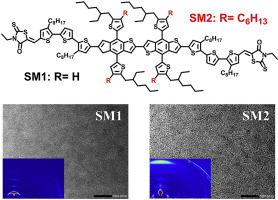Nano Energy ( IF 16.8 ) Pub Date : 2020-03-14 , DOI: 10.1016/j.nanoen.2020.104708 Sora Oh , Nasir Khan , Seon-Mi Jin , Huyen Tran , Namsun Yoon , Chang Eun Song , Hang Ken Lee , Won Suk Shin , Jong-Cheol Lee , Sang-Jin Moon , Eunji Lee , Sang Kyu Lee

|
The molecular self-organization of organic semiconductors, which is mainly determined by the structural design, film processing, and device configuration, is one of the crucial factors for achieving high-performance organic photovoltaics (OPVs) and perovskite solar cells (PvSCs). In this study, we newly synthesized and developed strongly self-organized small molecules via alkyl side-chain engineering. Replacing “H” to “C6H13” on the thienyl group, SM2 showed a well-ordered face-on orientation. Due to favorable self-organization leading to effective charge carrier dynamics, including enhanced charge transfer/transport and suppressed recombination, SM2-based OPVs and PvSCs exhibited improved device performance compared to the devices based on SM1 without an additional hexyl side-chain. The best fullerene-based OPV and planar PvSC with SM2 as a small-molecule donor and as a hole transport layer (HTL) achieved an unprecedentedly high efficiency of 9.38% and 20.56%, in contrast with SM1-based devices showing lower efficiency of 8.70% and 15.37%. Furthermore, the planar PvSCs based on undoped-SM2 HTL exhibited comparable efficiency but provided excellent heat and humidity stability compared with doped spiro-OMeTAD-based devices. These results clearly indicated that SM2 with highly-ordered and favorable self-organization is a promising organic semiconductor for future applications of high-performance organic and inorganic-organic hybrid electronics.
中文翻译:

小分子的烷基侧链依赖性自组织及其在高性能有机和钙钛矿太阳能电池中的应用
有机半导体的分子自组织主要由结构设计,薄膜加工和器件配置决定,是实现高性能有机光伏(OPV)和钙钛矿太阳能电池(PvSC)的关键因素之一。在这项研究中,我们通过烷基侧链工程新合成并开发了强自组织的小分子。将“ H”替换为“ C 6 H 13”在噻吩基上,SM2显示出整齐的面朝上取向。由于良好的自组织导致有效的电荷载流子动态,包括增强的电荷转移/传输和抑制的重组,与基于SM1的器件相比,基于SM2的OPV和PvSC的器件性能有所提高,而没有附加的己基侧链。最佳的基于富勒烯的OPV和平面PvSC以及SM2作为小分子供体和空穴传输层(HTL),实现了前所未有的高效率,分别为9.38%和20.56%,而基于SM1的器件的效率更低,为8.70 %和15.37%。此外,与基于掺杂螺旋-OMeTAD的器件相比,基于非掺杂SM2 HTL的平面PvSC表现出可比的效率,但具有出色的热稳定性和湿度稳定性。











































 京公网安备 11010802027423号
京公网安备 11010802027423号